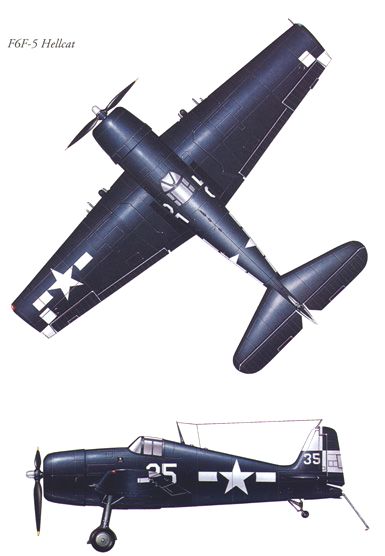
Without doubt, the best carrier-based fighter of World War Two, was the Grumman F6F Hellcat. A larger and more powerful development of the earlier F4F Wildcat, the Hellcat was designed to counter Japan's excellent Zero fighter. The Hellcat was armed with six .50 caliber machine guns as well as rockets, and the wings folded flat against the fuselage so more could fit on board aircraft carriers. The Hellcat's design sacrificed speed for a high rate of climb and exceptional maneuverability. It was also a very rugged and well armored design. The Hellcat first flew in June 1942 and was deployed operationally in the Pacific in August 1943 where it participated in every major engagement of the war. At one point in 1944 Grumman was turning out one Hellcat per hour - 644 in one month - an aircraft production record which has never been equaled. A total of 12,275 were built.






Patterned after the Hornet (CV-8), the Essex Class Carriers were to receive some significant structural changes. The Essex would be designed to carry two squadrons of airplanes versus the normal load of one squadron. This increase in planes would necessitate and enlargment of both the flight deck and hull. More stowage space for fuel and armaments called for a thicker hull to protect these vital materials. An elevator was positioned on the side of the carrier allowing uninhibited usage during flight operations. The superstructure or "island" would comprise the command center along with the captain's bridge. This increase in size would also allow for improved visibility to aid in ship handling. Consequently, these structural changes would increase the ships displacement requiring an expansion is ship power requiring eight Babcock and Wilcox boilers. These boilers would be used to produce enough horsepower to propell the ship at over 30 knots.

IJN Shokaku under attack by U.S. aircraft.

Taiho Fleet Carrier
Similiar in desaign to the earlier Shokaku class, Taiho was Japan's largest purpose-built aircraft carrier and the first to feature an armored deck. Total armor weight on this ship came to 8,800 tons which was a very high number for an aircraft carrier. She was destroyed only a few weeks after entereing service by a single torpedo hit from the US sub Albacore which ignited fuel vapors and blew her up.
Two more vessels were planned to her design and a further 5 to a modified design.

IJN Hiyo